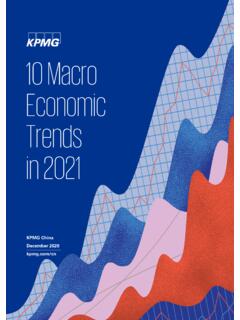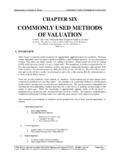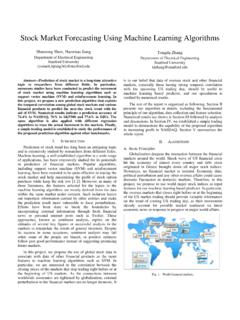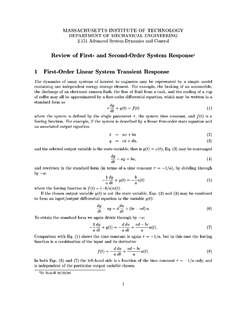Transcription of Chapter V Environmental sustainability
1 Chapter VEnvironmental sustainabilitySummary Progress has been made in some Environmental areas since 1990: Ozone-depleting substances have been virtually eliminated, and the ozone layer is expected to recover by the middle of this century; terrestrial and marine protected areas in many regions have increased substantially; 147 countries have met the drinking water target, 95 countries have met the sanitation target and 77 countries have met both; and the proportion of urban population living in slums in developing regions fell notably. The international community must ensure that the United Nations Framework Convention on Climate Change (UNFCCC) process gives way to necessary cooperation between developed countries and the large, fast-growing developing countries in order to meet carbon dioxide (CO2) emission-reduction targets.
2 Efforts to protect forests will have to be combined with sustainable production and consumption patterns. It must be acknowledged that deforestation is caused by factors beyond the forest sector s control, necessitating integral approaches. The special role of forests in the life and livelihood of people living in poverty and indigenous peoples should be given adequate attention. Protection of certain terrestrial and marine areas can be simultaneously helpful for protection of forests, wetlands, biodiversity, water resources, fish stock, and so forth. This in turn is critical to avoiding economic hardships, social tension and conflicts. Addressing the issue of climate change should help in the protection of terrestrial and marine areas.
3 Adequate drinking water and sanitation infrastructure can best be built through public initiatives, both at national and local levels, complemented by various community and non-governmental initiatives. Infrastructure should be environmentally friendly to avoid negative externalities that have emerged as access to drinking water and sanitation is expanded. The slums problem can only be solved through sustained, inclusive and equitable economic growth, grounded in sustainable patterns of production and consumption, sustainable urbanization, and deeper human development. Achieving this will take time; intermediate steps towards improving the lives of slum dwellers will need to be taken in the meantime.
4 Going forward, coherent policies should make use of the interconnections between various Environmental goals themselves and between Environmental and human development goals in order to accelerate progress. This will require finding targets and indicators that capture these interlinkages in an integrated manner whose quantitative nature also permits better monitoring of economic and Social Survey 2014/2015 IntroductionIn addition to human development aspirations, the Millennium Development Goals (MDGs) also embraced multidimensional efforts at both the international and national levels that were aimed at protecting the environment. MDG 7 was formulated to ensure Environmental sustainability in recognition of a growing concern about current consumption and production patterns leading to an unsustainable use of natural resources.
5 The purpose of this Chapter is to review efforts made towards Environmental sustainability during the 2000-2015 period, to understand the ways in which these efforts contributed to making progress towards Environmental sustainability targets of the MDGs, and draw lessons for the implementation of the 2030 Agenda for Sustainable Development, and the Sustainable Development Goals (SDGs) in particular. Any analysis of efforts to achieve MDG 7 is challenged by the unique features of this goal, especially the diversity of its targets (see the annex to this Survey). The targets are heterogeneous, covering both human development and Environmental issues without proper integration; none of the environment-related targets were quantitatively specified; and some targets are not time-bound (for example, target A) whereas others are (for example, target B, which was expected to be met in 2010).
6 Goal 7 also covers only a subset of the many challenging Environmental issues that need to be addressed (Rockstr m and others, 2009). Moreover, while other MDGs are directed to either developing countries (MDGs 1-6) or developed countries (MDG 8), targets A and B are set for all countries, representing universality and the need for global cooperation, a feature that is more akin to the SDGs. One of the indicators for monitoring progress on MDG 7 refers to carbon dioxide (CO2) emissions. This implicitly brings in the Rio principle of Common But Differentiated Responsibility (CBDR), given that developing countries will need some space to address emissions while working to develop more sustainable economic systems with higher levels of per capita protection efforts worldwide during the 2000-2015 period are also unique in that they have not only responded to stimuli from the MDGs but also from several other sources, including (i) multilateral agreements, such as the UNFCCC, the Convention on Biological Diversity (CBD), the United Nations Convention to Combat Desertification (UNCCD)
7 And the Convention on Wetlands (Ramsar Convention); (ii) other regional initiatives; and (iii) spontaneous responses of individuals, communities, non-governmental and civic organizations, business organizations, and nations to growing Environmental threats. Hence, unlike previous chapters where the focus was mostly on national policies and efforts, the review in this Chapter gives more weight to internationally and regionally organized efforts as well. This Chapter s review of Environmental protection classifies the issues covered in MDG 7 into the following four major groups: (i) atmospheric issues; (ii) forests; (iii) land, water and biodiversity issues; and (iv) drinking water, sanitation, and slums.
8 This grouping is neither exhaustive (that is, not all aspects of the Environmental targets are covered with the same details) nor does it mean that there are no significant overlaps across these issues. For example, deforestation (a land-use issue) is a major driver of climate change and a major factor in sustainable water management. Similarly, success in ensuring improved drinking water often depends on the management of water resources. In fact, the importance of the overlaps across issues is underlined repeatedly in this Chapter . Overarching lessons as well as lessons for specific areas of MDG 7 that emerge from the review of efforts are presented at the end of the MDG framework embraced multidimensional efforts to protect the environment which, unlike other MDGs, were designed to apply to all countries115 Chapter V.
9 Environmental sustainabilityProtecting the atmosphere to combat climate change1 A growing concern about the unsustainable use of natural resources as a result of current consumption and production patterns prompted the MDG agenda to introduce Environmental targets. The concern was well founded: continuous population and gross domestic product (GDP) growth has resulted in growing volumes of resources extracted and waste generated (figure ).2 In fact, over time, the crisis has become more severe with regard to the absorption of waste particularly CO2 emissions, which continue to exceed the absorptive capacity of the atmosphere, oceans and forests. A positive correlation has been established between growth and carbon emissions in developing countries (figure and figure ), although CO2 intensity in GDP has exhibited a downward trend.
10 Even in developed countries (figure ), where post-industrial structural transformation, new technology, trade, outsourcing and certain Environmental policies have resulted in a relative decoupling between carbon emissions and growth, emissions can still increase when GDP growth per capita accelerates beyond a certain threshold ( , above 2 per cent).The decline in the emissions per unit of GDP is primarily the result of deployment of new, more fuel-efficient and lower-emitting technologies. This experience is sometimes put forward as evidence supporting the possibility of decoupling of growth from carbon emissions. However, the decoupling that this evidence shows is relative decoupling, while 1 This section draws extensively from Shindell (2015).



















